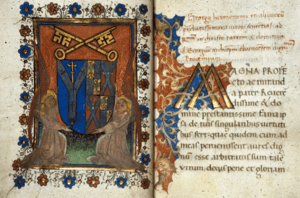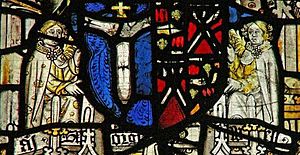George Neville (bishop) facts for kids
Quick facts for kids George Neville |
|
|---|---|
| Archbishop of York | |

Arms of George Neville, Archbishop of York (British Library, MS Harl.3346 ff.4v-5), c.1475.
|
|
| Appointed | 15 March 1465 |
| Enthroned | September 1465 |
| Reign ended | 8 June 1476 |
| Predecessor | William Booth |
| Successor | Lawrence Booth |
| Other posts | Bishop of Exeter Archdeacon of Durham |
| Orders | |
| Consecration | 3 December 1458 |
| Personal details | |
| Birth name | George Neville |
| Born | c. 1432 |
| Died | 8 June 1476 |
| Denomination | Roman Catholic |
George Neville (born around 1432 – died 8 June 1476) was an important leader in England. He served as the Archbishop of York from 1465 to 1476. He was also the Chancellor of England, a top government job, from 1460 to 1467 and again from 1470 to 1471.
Contents
Early Life and Career
George Neville was the youngest son of Richard Neville, 5th Earl of Salisbury. His mother was Alice Montagu, 5th Countess of Salisbury. He was also the brother of Richard Neville, 16th Earl of Warwick, who was very powerful and known as the "Kingmaker."
George went to Balliol College, Oxford for his education. From a young age, he was expected to join the church. Because his family was so influential, he quickly moved up in the church. He became the Bishop of Exeter in 1458. He was officially given this role on February 4, 1458, and became a bishop on December 3, 1458.
Involvement in Politics
From this time on, George Neville became very involved in the difficult politics of his era. He was with his brother Warwick at the Battle of Northampton in July 1460. Right after this battle, he was given the "Great Seal," which meant he had a very important government position.
Neville helped to announce Edward IV as the new king. King Edward IV then confirmed George Neville's role as Chancellor. In 1463, he went on an important trip to France to talk with leaders there. In 1464, he helped with talks with people from Scotland. Around 1463, he also became the Archdeacon of Carlisle. On March 15, 1465, he became the Archbishop of York. He also served for many years as the head of the University of Oxford.
Archbishop of York Enthronement
George Neville's official ceremony as Archbishop of York happened at Cawood Castle in September 1465. This event was a huge party that showed how rich and powerful his family was.
The Grand Feast
Many important people came to the castle for the celebration. There were 28 lords, 59 knights, 10 abbots (heads of monasteries), 7 bishops, and many lawyers, church leaders, and ladies. Along with their helpers and servants, about 2,500 people needed to be fed at each meal.
The amount of food they ate was incredible:
- 4,000 pigeons and 4,000 crayfish
- 2,000 chickens and 204 cranes
- 104 peacocks and 100 dozen quails
- 400 swans and 400 herons
- 113 oxen and 6 wild bulls
- 608 pike and bream (types of fish)
- 12 porpoises and seals
- 1,000 sheep and 304 calves
- 2,000 pigs and 1,000 capons (roosters)
- 400 plovers and 200 dozen 'rees' (a type of bird)
- 4,000 mallards and teals (ducks)
- 204 young goats and 204 bitterns (birds)
- 200 pheasants and 500 partridges
- 400 woodcocks and 100 curlews
- 1,000 egrets and over 500 deer
- 4,000 cold and 1,500 hot venison pies
- 4,000 dishes of jelly and 4,000 baked tarts
- 2,000 hot custards
- Lots of bread, sweet treats, and cakes
- 300 barrels of ale and 100 barrels of wine
This huge menu not only showed the power of the Neville family but also gives us a good idea of the birds and animals that were common in England in the 1400s.
Later Years and Imprisonment
In the years after his enthronement, George Neville and his brothers lost favor with King Edward IV. In June 1467, King Edward took back the Great Seal from Neville. This was a punishment because Neville had tried to stop the king's plans.
In 1469, there was a successful uprising in Yorkshire. George Neville's brother, Warwick, secretly encouraged this uprising. The king was captured by the archbishop. After being held for a short time, the king was allowed to escape.
When Warwick was later defeated by the king's army in 1470, Archbishop Neville promised to support Edward. However, during a short time when Henry VI became king again (which forced Edward to leave England), Neville worked as Chancellor for Henry VI. When Edward IV became king again, Neville quickly made peace with him. He did this by handing Henry VI over to Edward. For a short time, the archbishop was also held captive with Henry in the Tower of London.
George Neville was pardoned in April 1471. But on April 25, 1472, he was arrested again. He was secretly taken to France and held prisoner at Hammes Castle near Calais. He remained a prisoner until November 1474, when he returned to England. He died the next year, on June 8, 1476.
Archbishop Neville was a respected scholar. He gave a lot of support to the University of Oxford, especially to Balliol College. He also seemed interested in learning Greek and even ordered a Greek book to be made.
See also
 In Spanish: George Neville (arzobispo) para niños
In Spanish: George Neville (arzobispo) para niños



